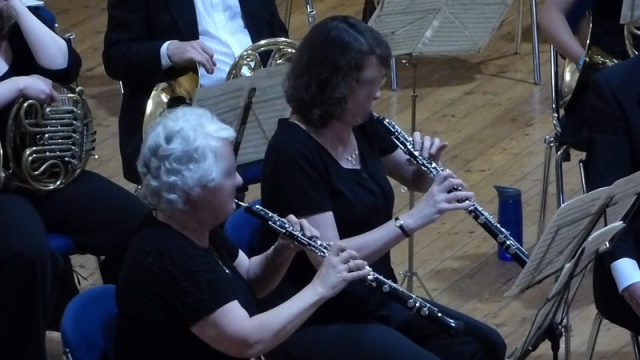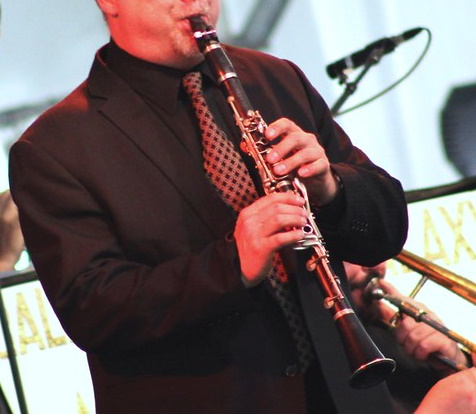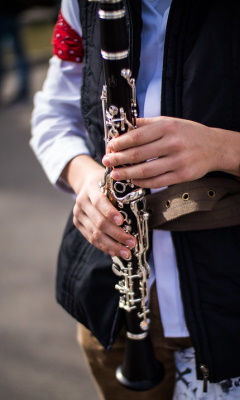Learning to play a woodwind instrument is exciting, but it can be hard to decide which one to choose. Many students question whether they should learn the oboe or the clarinet
While the oboe and the clarinet both sound beautiful, the oboe has a steeper initial learning curve due to a tricky embouchure and using a double reed. The oboe also has a higher cost than the clarinet, including for reeds. The clarinet is also more versatile for playing non-classical music.
Table of Contents
Oboe vs clarinet: learning curve
Most people agree the oboe is more difficult to learn than the clarinet, at least at the beginning.
Embouchure
The embouchure (how you use the muscles of your mouth to play a wind instrument) for the oboe involves playing a double reed. This is two blades of cane tied together.
You put your lips over your teeth and blow between the two blades, causing them to vibrate and make sound. It can be tricky to get the oboe embouchure right as working up the muscle strength takes time.
On the clarinet, the embouchure is a bit simpler. You put your lower lip over your teeth, your top teeth on the mouthpiece and close your lips to make a seal.
When you blow into the clarinet, a single reed vibrates against the mouthpiece. Once your embouchure is correct, you work to build the muscles needed for endurance.
Using reeds
On the oboe, since there is no mouthpiece helping produce the sound, the reed is vital. A bad reed makes it nearly impossible for even a professional player to sound good. Thus, it’s typically more difficult to deal with reeds on the oboe than the clarinet.
Private lessons
Many students take private lessons to supplement their band class, a great way to get better faster. It’s generally easier to find a good teacher for the clarinet than for the oboe.
Clarinet vs oboe cost & maintenance

The price of equipment is an important consideration when deciding whether to learn the oboe or the clarinet.
Oboes tend to be more expensive than similar quality clarinets. This is mostly because the oboe has more complex keywork. Examples of oboe and clarinet prices:
| Model | Material | Price |
| Beginner Oboes | ||
| Fox Renard Model 330 | Plastic | $4,200 |
| Yamaha YOB 241 | Plastic | $3,100 |
| Beginner Clarinets | ||
| Buffet Crampon Premium Bb Clarinet | Plastic | $700 |
| Yamaha YCL 255 | Plastic | $1,100 |
| Intermediate Oboes | ||
| Buffet Protege Performance C | Wood | $3,900 |
| Yamaha YOB 441 | Wood | $3,500 |
| Intermediate Clarinets | ||
| Buffet Crampon E12F | Wood | $2,100 |
| Yamaha YCL 650 | Wood | $2,000 |
When purchasing an oboe, you need to make choices on which keys you would like – how many octave keys, and whether there is a left hand F lever.
Cost of accessories
Both instruments require additional accessories that add to the cost. For the clarinet, a mouthpiece usually comes with the instrument when purchased.
However, as the player progresses, they’ll often need a better mouthpiece in order to play and sound better. Prices for a clarinet mouthpiece can cost anywhere from $90 to $300.
Double reeds for the oboe are more expensive and fragile than single reeds for the clarinet. Oboe reeds that are factory produced cost $15-$35 each and are relatively low quality.
Clarinet reeds don’t cost as much, generally from $19 to $33 for a box of 10.
Maintenance
Both instruments need to be taken care of in order to assure they play properly. In time, small repairs may be necessary, like replacing a pad or spring, due to wear and tear.
For these types of small repairs on the clarinet, you or your band director may be able to fix it. For an oboe, in contrast, because the keywork is more complex, the instrument often needs to be sent to a music repair shop. Likewise for reed work.
Fingerings

Learning the fingerings for notes is typically easier on oboe, because it has a smaller pitch range than the clarinet. Also, the oboe changes registers at the octave, so a D3 has almost the same fingering as a D4.
On the oboe, the fingers are spaced wider apart, which can sometimes be uncomfortable, especially for someone with small hands. The holes are not all completely open, which makes playing easier.
You also can get a “Little Hands Kit,” with the student Buffet oboe. In the kit are clippable plastic pieces which can be placed over the open holes. This makes it much easier to reach the keys.
The clarinet has a wider pitch range than the oboe. While this is a good attribute, it does mean that there are more fingerings to learn and remember.
What’s more, the clarinet changes registers at a 12th rather than the octave. This means you use different fingerings for notes in different octaves.
Clarinet is an open hole instrument. Learning to completely cover the holes for a fingering can be a challenge, especially for young students with small fingers.
Composers often give Clarinetists fast-moving, technical music to play. While oboists play technical music, too, you see this in clarinet music of all styles.
Selecting vs making reeds
As discussed, clarinet reeds are cheaper per reed than oboe reeds. They are less consistent, though, so not all of the reeds in a box play well.
The technology behind making synthetic clarinet reeds continues to improve. Légère makes synthetic clarinet reeds that are quite good. They are more expensive than cane reeds at around $26 per reed, but they last much longer and are more durable than standard reeds.
Oboe students often take private lessons with an oboe specialist. Most often, the teacher makes their own reeds and can sell handmade reeds to their students.
Handmade reeds can be more finely tuned to the needs of the player. Eventually, the oboe student will need to learn how to make their own reeds, which takes considerable time and can be costly.
Clarinet vs oboe: demand & competition

When considering which instrument to learn, it’s important to consider what the competition will be like for playing in an ensemble.
Many people play the clarinet, so there can be more competition when it comes to activities like chair placement in a band or admission to honor bands and orchestras. It’s harder to set yourself apart from other clarinetists.
On the other hand, more clarinets are needed in a band. A band often needs around 12-15 clarinets vs only 1-2 oboes.
Since there are fewer people playing the oboe, it’s easier to stand out if you’re good. On the other hand, there can still be stiff competition since there aren’t as many spots available in ensembles.
The best way to rise above the rest on either instrument is to take private lessons along with band. This will help you progress farther faster by addressing problems that are particular to you playing the instrument.
Prominence in classical repertoire
The oboe was invented around the middle of the 17th Century, while the clarinet wasn’t invented and used regularly until the 18th Century.
This is one reason why there is a bigger variety of literature, especially from the Baroque Period, for the oboe than the clarinet.
Since the clarinet became a standard instrument in the orchestra in the 18th Century, a good amount of music has been written for both instruments.
Composers have written solos, chamber music and parts in orchestral and band compositions for both oboe and clarinet.
Versatility for playing outside of classical music
Both the oboe and the clarinet can play a variety of styles. If you’re interested in playing something like a country or pop song, it can be easier to play the oboe. This is because the oboe is pitched in C.
As a result, the oboe is able to play a good deal of flute music. Playing a song like this on the clarinet requires you to transpose because the clarinet is pitched in Bb.
However, the clarinet is used more widely in jazz than the oboe. Whether you’re playing Dixieland or Swing, you’re more likely to be asked to play clarinet. Many jazz saxophonists double on clarinet.
Clarinet or oboe: final words
A big factor in choosing an instrument and sticking with it is whether or not you enjoy playing the instrument. A student who likes playing the oboe and likes the sound of an oboe is much more likely to continue playing and progressing.
It’s a very good idea to try out both instruments to see which one you like better. Your band director or private music lesson teacher can guide you in how to make a sound on each instrument. Then you can get a hands-on experience to help you decide.
Also listen to a recording of a professional oboist and of a professional clarinetist. This will really give you an idea of what the instruments are capable of. Which instrument sounds the most beautiful to you? Which sounds like it would be fun to play?
***
Photo credits:
Featured image:
– “oboes” (Public Domain) by kercia evelyn silva
– “clarinet” (CC BY 2.0) by jmmcdgll
(1) “Oboes” (CC BY 2.0) by jeremySO
(2) “Clarinet” (CC BY 2.0) by richardha101
(3) “Musician at carnival with an oboe in han” (CC BY 2.0) by Ivan Radic

